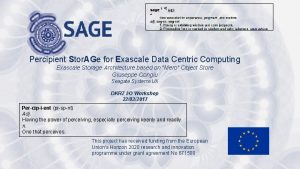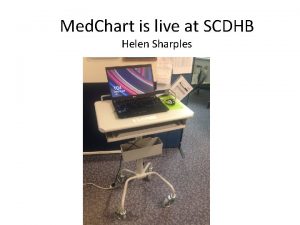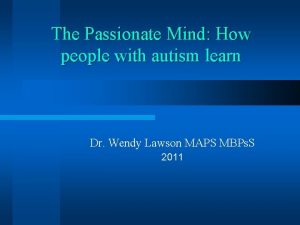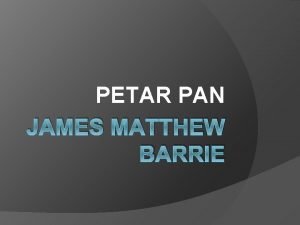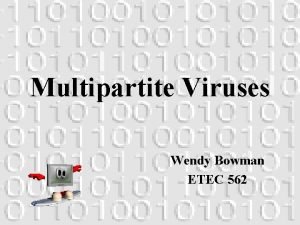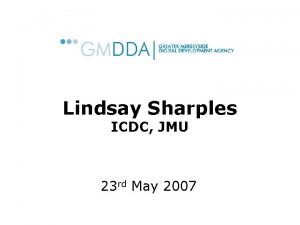Life in a post exascale world Wendy Sharples

































- Slides: 33

Life in a post exascale world Wendy Sharples 1, Klaus Görgen 2, and Chantal Donnelly 3 1 Water Program, Bureau of Meteorology, Melbourne Australia 2 Jülich Supercomputing Centre, Jülich Research Centre, Jülich Germany 3 Water Program, Bureau of Meteorology, Brisbane, Australia November 2019

What will life be like in a post exascale computing world?

What is exascale? • One quintillion operations per second = 1, 000, 000 operations/s Rate of 1 billion grains of sand per second

What is exascale? • One quintillion operations per second = 1, 000, 000 operations/s …. . 1 billion

What is exascale? • One quintillion operations per second = 1, 000, 000 operations/s ) etta K ( r 17 0 2 i, n te p kto s e ad an h t l rfu lops) e w po petaf e r mo in ~ 2 s e ij m a i t R ( n illio aflops m • 1 00 pet 0 • 1 pu m o c …. . 1 billion

Exascale computers: Using these systems we can start to solve formerly intractable problems in fields such as: Energy Current capability: A fully blade resolved model of a single turbine requires the full computing capability of today's fastest computers https: //exawind. org

Exascale computers: Using these systems we can start to solve formerly intractable problems in fields such as: Energy Exascale capability: A fully blade resolved model of an entire wind plant https: //exawind. org

Exascale computers: Using these systems we can start to solve formerly intractable problems in fields such as: Health care Current capability: • Understanding how RAS mutations evolve – simulation of 2 RAS proteins on a 30 x 30 nm patch of lipid membrane https: //candle. cels. anl. gov/

Exascale computers: Using these systems we can start to solve formerly intractable problems in fields such as: Health care Exascale capability: • Understanding how RAS mutations evolve – simulation of 64 RAS proteins on 150 x 150 nm patch of lipid membrane https: //candle. cels. anl. gov/

Exascale computers: Using these systems we can start to solve formerly intractable problems in fields such as: Earth system modelling Current capability: Earth system model at 1 km resolution: A few days https: //e 3 sm. org

Exascale computers: Using these systems we can start to solve formerly intractable problems in fields such as: Earth system modelling Exascale capability: Earth system model at 1 km resolution: 100 years https: //e 3 sm. org

Exascale computers: Using these systems we can start to solve formerly intractable problems in fields such as: Astrophysics Current capability: Cosmological simulations- gravity only simulation https: //press 3. mcs. anl. gov/cpac/projects/exasky/

Exascale computers: Using these systems we can start to solve formerly intractable problems in fields such as: Astrophysics Exascale capability: Cosmological simulations - gravity plus gas dynamics plus astrophysical feedback mechanisms https: //press 3. mcs. anl. gov/cpac/projects/exasky/

Challenges and opportunities: • Main challenges: – Scalability

Challenges and opportunities: • Main challenges: – Scalability How do we handle: • job scheduling • data structures • message passing when using huge numbers of nodes? Is there a limit to Moore's law? Memory performance (latency)

Challenges and opportunities: • Main challenges: – Scalability – Power consumption Holmes et al. , 2013

Challenges and opportunities: • Main challenges: – Scalability – Power consumption Need to consider: • CPU power consumption • Memory power consumption • Different types of processors e. g. cryogenic processors Holmes et al. , 2013

Challenges and opportunities: • Main challenges: – Scalability – Power consumption – Big data Demchenko et al. , 2013

Challenges and opportunities: • Main challenges: – Scalability – Power consumption – Big data • Need to store, access and analyse data from very high resolution simulations • Current database and data management tools are struggling with the amount of data produced Demchenko et al. , 2013

Challenges and opportunities: • Solutions: – Heterogeneous architecture https: //fz-juelich. de O’Brien et al. , 2017

Challenges and opportunities: • Solutions: – Heterogeneous architecture n tio p m nsu o c wer ity o p rs bil ance e a l w a Lo sc s orm t f r s e o Bo r IO p des e o Bett ialist n c Spe https: //fz-juelich. de O’Brien et al. , 2017

Challenges and opportunities: • Solutions: – Heterogeneous architecture – Hierarchical memory optimization Chen & Agrawal, 2012

Challenges and opportunities: • Solutions: – Heterogeneous architecture – Hierarchical memory optimization n tio p m u ns o c wer ity o p rs bil e a l w a Lo sc s t s Boo Chen & Agrawal, 2012

Challenges and opportunities: • Solutions: – Heterogeneous architecture – Hierarchical memory – Complex interconnectivity https: //fuse. wikichip. org

Challenges and opportunities: • Solutions: – Heterogeneous architecture – Hierarchical memory – Complex interconnectivity n tio p m u ns o c wer ity o p rs bil e a l w a Lo sc lerance s t s Boo fault to High https: //fuse. wikichip. org

Challenges and opportunities: • Solutions: – Heterogeneous architecture – Hierarchical memory – Complex interconnectivity – Co-design approach Bespoke systems, chips, and interconnectivity => complicated programming paradigms

Challenges and opportunities: • Solutions: – Heterogeneous architecture – Hierarchical memory – Complex interconnectivity – Co-design approach “The idea behind the co-design center is that, instead of everyone bringing their own specialized methods, we identify a set of building blocks, and then find the right way to deal with the common problems associated. ” Salman Habib, Argonne lead in Co. PA

Challenges and opportunities: • Solutions: – Heterogeneous architecture – Hierarchical memory – Complex interconnectivity – Co-design approach on m m co e r on u i t t p a a c nic h u c m i m e h t sys ods w nd com o c ee eth tion a r m a tw behind ta “The co-design center is that, ing the p u t t Sofidea u m c o s s everyone instead of c bringing their own Cro ofrn s e specialized patt methods, we identify a set of building blocks, and then find the right way to deal with the common problems associated. ” Salman Habib, Argonne lead in Co. PA

What does exascale mean for the Bureau? As exascale becomes the "new normal" supporting software ecosystems will increase in complexity • Using these systems efficiently requires substantial investment: – to redesign code (Fu et al. , 2017) https: //xkcd. com/license. html

What does exascale mean for the Bureau? As exascale becomes the "new normal" supporting software ecosystems will increase in complexity • Using these systems efficiently requires substantial investment: – to redesign code (Fu et al. , 2017) – in specialist knowledge (Kogge & Shalf, 2013) https: //xkcd. com/license. html

What does exascale mean for the Bureau? The Bureau will need to weigh up whether to: Invest early Pros Cons Keep up with world efforts Develop Bo. M centric applications Collaboration opportunities $$$

What does exascale mean for the Bureau? The Bureau will need to weigh up whether to: Wait until established frameworks and libraries are in place Pros Cons Easy to use standard APIs Mature system compilers and code annotation tools Reduced investment overheads Left behind

What is the “right” answer?
 Wendy sharples
Wendy sharples Exascale definition
Exascale definition Roy sharples
Roy sharples Helen sharples
Helen sharples Christina rossetti song analysis
Christina rossetti song analysis The passionate mind
The passionate mind Wendy levinson
Wendy levinson Speakertone tubbys menu
Speakertone tubbys menu The veldt characters
The veldt characters Tich miller by wendy cope poem
Tich miller by wendy cope poem Petar pan i kapetan kuka
Petar pan i kapetan kuka Wendy kinnear
Wendy kinnear Does cms use ncdr registry
Does cms use ncdr registry Wendy bowman facts
Wendy bowman facts Wendy truvillion
Wendy truvillion Ryan cronin comptroller
Ryan cronin comptroller Main character in peter pan
Main character in peter pan Wendy blount dvm
Wendy blount dvm Wendy myrvold
Wendy myrvold Wendy doyle
Wendy doyle Mount pleasant tx animal shelter
Mount pleasant tx animal shelter How to write wendy in cursive
How to write wendy in cursive Wendy truvillion
Wendy truvillion Wendy truvillion
Wendy truvillion Animals building homes by wendy perkins
Animals building homes by wendy perkins Wendy's strengths
Wendy's strengths Wendy brotherton
Wendy brotherton Sex industry
Sex industry Wendy blount dvm
Wendy blount dvm Wendy dean moral injury
Wendy dean moral injury Wendy stout
Wendy stout Wendy graham
Wendy graham Wendy boller
Wendy boller Self introduction
Self introduction

